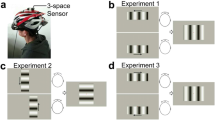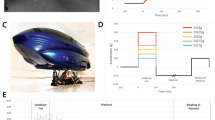Abstract
The flash-lag phenomenon is an illusion that affects the perceived relationship of a moving object and a briefly visible one: the moving object appears to be ahead of the flashed one. In practically all studies of this phenomenon, the image of the object moves on the retina as the object moves in space. Therefore, explanations of the illusion were sought in terms of purely visual mechanisms. Here we set up a situation in which the object’s motion in space is entirely produced by passive rotation of the subject. No motion occurred on the retina. The visual display (a continuously lit stimulus and a flashed one) was mounted on a vestibular chair. While the subjects fixated this display, they were rotated in the dark at a constant speed and suddenly stopped. Perceptual misalignment (flash-lag) was robust and consistent during both the initial phase of rotation and the postrotary period when neither chair, subject, nor stimulus was actually moving. As a vestibular signal can cause an illusory spatial dissociation in the visual domain, we conclude that the mechanism of the flash-lag must be more general than was thought up-to-now.
Similar content being viewed by others
References
Baldo MVC, Klein SA (1995) Extrapolation or attention shift? Nature 378:565–566
Belton T, McCrea RA (1999) Contribution of the cerebellar flocculus to gaze control during active head movements. J Neurophysiol 81:3105–3109
Cai RH, Pouget A, Schlag-Rey M, Schlag J (1997) Perceived geometrical relationships affected by eye-movement signals. Nature 386:601–604
Eagleman DM, Sejnowski TJ (2000) Motion integration and post-diction in visual awareness. Science 287:2036–2038
Fukushima K, Sato T, Fukushima J, Shimmei Y, Kaneko CRS (2000) Activity of smooth pursuit-related neurons in the monkey periarcuate cortex during pursuit and passive whole-body rotation. J Neurophysiol 83:563–587
Honrubia V, Khalili R, Baloh RW (1992) Optokinetic and vestibular interactions with smooth pursuit. Ann NY Acad Sci 656:739–746
Kase M, Noda H, Suzuki D, Miller D (1979) Target velocity signals of visual tracking in ventral Purkinje cells of the monkey. Science 205:717–720
Krekelberg B, Lappe M (1999) Temporal recruitment along the trajectory of moving objects and the perception of position. Vision Res 39:2669–2679
MacKay DM (1958) Perceptual stability of a stroboscopically lit visual field containing self-luminous objects. Nature 181:507–508
Nijhawan R (1994) Motion extrapolation in catching. Nature 370:256–257
Puruschothaman G, Patel SS, Bedell HE, Ogmen H (1998) Moving ahead through differential visual latency. Nature 396:424
Ross J, Morrone MC, Burr B (1997) Compression of visual space before saccades. Nature 386:598–601
Schlag J, Cai RH, Dorfman A, Mohempour A, Schlag-Rey M (2000) Extrapolating movement without retinal motion. Nature 403:38–39
Sheth BR, Nijhawan R, Shimojo S (2000) Changing objects lead briefly flashed ones. Nat Neurosci 3:489–495
Snowden RJ (1998) Shifts in perceived position following adaptation to visual motion. Curr Biol 8:1343–1345
Thier P, Erickson RG (1992) Responses of visual-tracking neurons from cortical area MST-1 to visual, eye and head motion. Eur J Neurosci 4:539–553
Whitney D, Murakami I, Cavanagh P (2000) Illusory spatial offset of a flash relative to a moving stimulus is caused by differential latencies for moving and flashed stimuli. Vision Res 40:137–149
Author information
Authors and Affiliations
Corresponding author
Additional information
Published online: 10 October 2000
Rights and permissions
About this article
Cite this article
Cai, R.H., Jacobson, K., Baloh, R. et al. Vestibular signals can distort the perceived spatial relationship of retinal stimuli. Exp Brain Res 135, 275–278 (2000). https://doi.org/10.1007/s002210000549
Received:
Accepted:
Issue Date:
DOI: https://doi.org/10.1007/s002210000549




